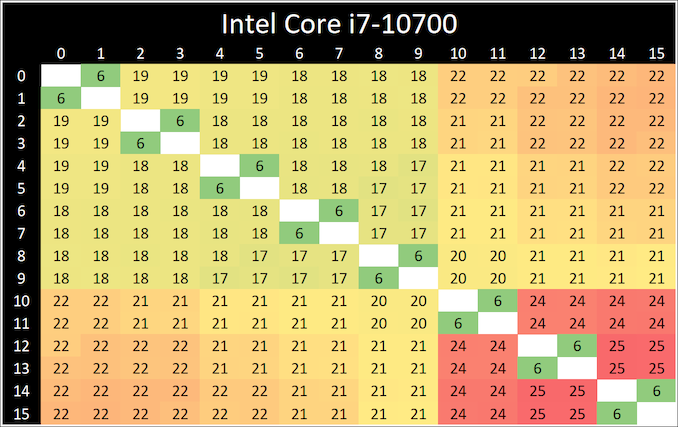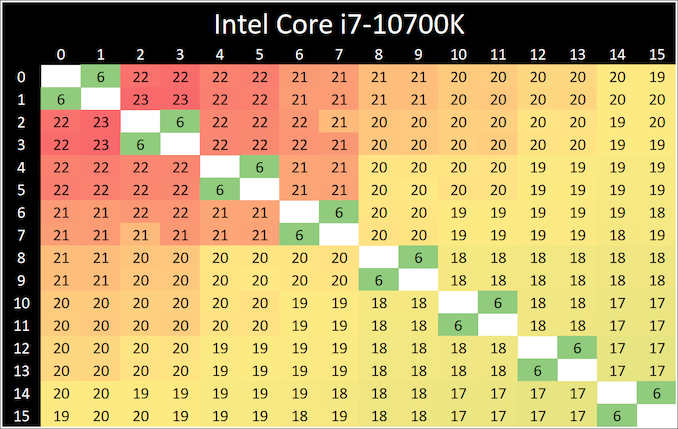Intel Core i7-10700 vs Core i7-10700K Review: Is 65W Comet Lake an Option?
by Dr. Ian Cutress on January 21, 2021 10:30 AM EST- Posted in
- CPUs
- Intel
- Core i7
- Z490
- 10th Gen Core
- Comet Lake
- i7-10700K
- i7-10700
CPU Tests: Microbenchmarks
Core-to-Core Latency
As the core count of modern CPUs is growing, we are reaching a time when the time to access each core from a different core is no longer a constant. Even before the advent of heterogeneous SoC designs, processors built on large rings or meshes can have different latencies to access the nearest core compared to the furthest core. This rings true especially in multi-socket server environments.
But modern CPUs, even desktop and consumer CPUs, can have variable access latency to get to another core. For example, in the first generation Threadripper CPUs, we had four chips on the package, each with 8 threads, and each with a different core-to-core latency depending on if it was on-die or off-die. This gets more complex with products like Lakefield, which has two different communication buses depending on which core is talking to which.
If you are a regular reader of AnandTech’s CPU reviews, you will recognize our Core-to-Core latency test. It’s a great way to show exactly how groups of cores are laid out on the silicon. This is a custom in-house test built by Andrei, and we know there are competing tests out there, but we feel ours is the most accurate to how quick an access between two cores can happen.
When we first reviewed the 10-core Comet Lake processors, we noticed that a core (or two) seemed to take slightly longer to ping/pong than the others. These two parts are both derived from the 10-core silicon but with two cores disabled, and we still see a pattern of some cores having additional latency. The ring on the 8-core parts still acts like a 10-core ring, but it all depends on which cores were disabled.
Frequency Ramping
Both AMD and Intel over the past few years have introduced features to their processors that speed up the time from when a CPU moves from idle into a high powered state. The effect of this means that users can get peak performance quicker, but the biggest knock-on effect for this is with battery life in mobile devices, especially if a system can turbo up quick and turbo down quick, ensuring that it stays in the lowest and most efficient power state for as long as possible.
Intel’s technology is called SpeedShift, although SpeedShift was not enabled until Skylake.
One of the issues though with this technology is that sometimes the adjustments in frequency can be so fast, software cannot detect them. If the frequency is changing on the order of microseconds, but your software is only probing frequency in milliseconds (or seconds), then quick changes will be missed. Not only that, as an observer probing the frequency, you could be affecting the actual turbo performance. When the CPU is changing frequency, it essentially has to pause all compute while it aligns the frequency rate of the whole core.
We wrote an extensive review analysis piece on this, called ‘Reaching for Turbo: Aligning Perception with AMD’s Frequency Metrics’, due to an issue where users were not observing the peak turbo speeds for AMD’s processors.
We got around the issue by making the frequency probing the workload causing the turbo. The software is able to detect frequency adjustments on a microsecond scale, so we can see how well a system can get to those boost frequencies. Our Frequency Ramp tool has already been in use in a number of reviews.
Both processors ramp from idle to full turbo in about six milliseconds, well within a single frame of standard gaming.













210 Comments
View All Comments
schujj07 - Friday, January 22, 2021 - link
A stock 3700X has a total package power of 88W and the 212 EVO is a 150W TDP cooler. Whereas the included Wraith Prism cooler with the 3700X is a 125W TDP cooler. One would expect that the larger capacity cooler with the larger fan would be quieter.vegemeister - Friday, January 22, 2021 - link
Heat transfer does not work that way.ΔT = P * R
where T is temperature (K), P is power (W), and R is thermal resistance (K/W).
Unless the temperature rise is known the only thing "150W cooler" tells you is that the heat pipes won't dry out at 150W with reasonable ambient temperature. (That's a thing that can happen. It's not permanent damage, but it does mean R gets a lot bigger.)
The fact is the Wraith Prism is the same 92mm downdraft cooler AMD has been shipping with their CPUs since the Phenom II 965.
Spunjji - Friday, January 22, 2021 - link
The Wraith Prisms are fine - the one that comes with the low-end ryzens (and I think now the 5600) aren't so great for noise, but they do let the CPU come within 95% of its peak performance, so not bad for a freebie.alufan - Thursday, January 21, 2021 - link
Am not seeing the point of this article is 65w an option and then you blatantly ignore the actual TDP stated and produce a test, for the test to be a fair comparison all the chips should be limited to actual power stated and then run through any Benchmarks, its like saying we are testing CPUs at 125w and including the LN2 FX AMD chip and seeing how much power you can actually run through it, running these chips like this constantly will degrade them and eat up a considerable amount of power that you dont need to use.Then again I should be surprised, yet again 12 articles on the front page regarding Intel 3 regarding AMD guess Intels media budget is bigger hmm
DominionSeraph - Thursday, January 21, 2021 - link
It's AMD CPUs that degrade at stock clocks. Intel will run for decades even with moderate overclocks.bji - Thursday, January 21, 2021 - link
AMD CPUs do not "degrade" at stock clocks or overclocks.DominionSeraph - Thursday, January 21, 2021 - link
Their Turbo is literally built around it. It will lower clocks as the chip degrades. The degradation is all over Reddit. I'm surprised no tech site has followed up on the scandal.bigboxes - Thursday, January 21, 2021 - link
I'm surprised there aren't more trolling like youSpunjji - Friday, January 22, 2021 - link
I'm not.I just spent a bit of time on Google and the majority of the results are people saying "I heard this, is it true?" - the rest are people talking about how they ran their chip way outside spec (significant overvoltage, overclock *and* high temperatures) and can no longer get the same overclock out of it.
Take your FUD and cram it. 🥰
Spunjji - Friday, January 22, 2021 - link
It took me less than 15 minutes to confirm that this is a lie.Incidentally, the only CPUs I've ever had "degradation" problems with were all Sandy Bridge - 2 i3s, one i5 and one i7. Only one of them was ever overclocked. They started to show strange issues after 3-5 years - stuff like frame-rate inconsistency in games, graphics artefacts, random crashes.
I've never gone around slamming Intel, though, because sometimes you just get a bad chip. It happens.